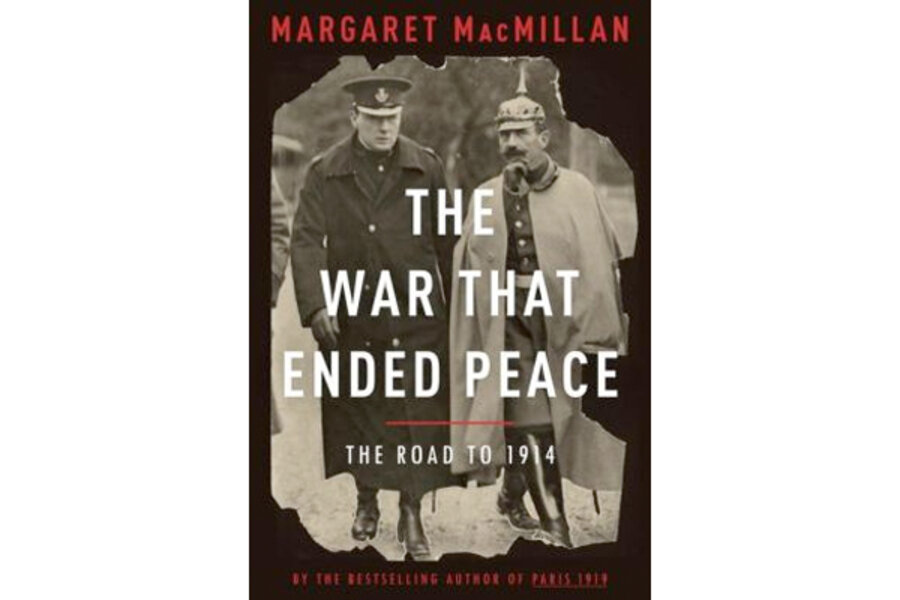The War That Ended Peace
Loading...
On July 28, 1914, Archduke Franz Ferdinand, the heir to the throne of Austria-Hungary, and his wife, Sophie, were assassinated in Sarajevo. Just over a month later, World War I broke out. It was arguably the most formative event of the 20th century. Millions died, four empires collapsed, and the most dramatic events in the years that followed – the Russian Revolution, World War II, and the Cold War – can be traced directly to the Great War.
Historians have long argued about why the war started and whether it could have been avoided. British intellectual Eric Hobsbawm believes that this single topic has commanded more attention among historians than any other subject. There is no way to know whether he’s right, but as the 100th anniversary of the conflict nears, we can expect another round of books that seek to answer history’s most basic question: Why?
Margaret MacMillan’s new book The War That Ended Peace: The Road to 1914 will be a welcome addition to these debates. An earlier book, “Paris 1919: Six Months that Changed the World,” which examined the drafting of the Treaty of Versailles that ended the war, established her reputation as one of the most gifted historians of our time. This book investigates the reasons that the war started and is a welcome and indispensable addition to this vast literature.
Her central argument is that “the outbreak of war in 1914 was a shock but it did not come out of a clear blue sky. The clouds had been gathering in the previous two decades and many Europeans were uneasily aware of that fact. Images of thunderstorms about to break, dams about to burst, avalanches ready to slide, these were quite common in the literature of the period.”
She cites a wide range of factors that led to the conflict. The growth of nationalism, national rivalries, and the desire for colonies all led to an arms race as nations sought the military capability to protect their interests. This, in turn, led to extensive war plans designed to ensure success if a conflict did break out. The slow collapse of the Ottoman Empire created a power vacuum in the Balkans that sparked terrific tensions between Austria-Hungary and Russia.
Also problematic were the diplomatic alliances that formed as nations sought security. The Triple Alliance (Germany, Austria-Hungary, and Italy) and the Triple Entente (Great Britain, France and Russia) were ostensibly designed for defensive purposes but, when the time came, they had the unfortunate effect of turning a regional dispute into a continental war.
A series of little-remembered diplomatic controversies further unsettled the European political order. MacMillan analyzes crises over Morocco in 1905 and 1911, Bosnia in 1908, and the Balkan Wars of 1912 and 1913. Any of these might have provoked a general war. They didn’t, but the tensions they created and hard feelings left in their wake were like dry kindling placed around a campfire – all it needed was a spark.
Finally, human beings made bad decisions. As MacMillan notes, “We should never underestimate the part played in human affairs by mistakes, muddle, or simply poor timing.” The litany of miscalculations and errors she recounts is enough to leave the reader breathless: Civilian leaders in Germany and Russia were not fully informed of their country’s war plans, even when they had political implications; some diplomatic leaders were on summer vacation and unreachable while others did not take the crisis seriously until it was too late; and the “blank check” of support that German Kaiser Wilhelm gave Austria should war break out all meant that human folly played a significant role as the crisis unfolded. Indeed, to MacMillan, it was ultimately the human element that was decisive: Europe went to war because too many of its leaders were inept.
Generations of readers learned about the start of World War I from “The Guns of August,” Barbara Tuchman’s legendary account of the summer of 1914. While it remains a well-regarded classic, her focus was on the day-to-day events that followed the assassination and she devoted little attention to the gathering storm that preceded it. MacMillan tells the story of the events after the assassination well, but what makes this book so valuable is that she takes a long look and examines the many forces that had been moving Europe in the direction of a war for a quarter century.
Like “Paris 1919,” this book is extensively researched and carefully organized. MacMillan is a master of narrative detail and the telling anecdote and this makes for a lively read. She does not break new ground in this book as much as present an exceptionally complex story in a way that will appeal to the general reader.
Those looking to understand why World War I happened will have a hard time finding a better place to start. This is a marvelous book.
Terry Hartle is senior vice president of government relations for the American Council on Education.






